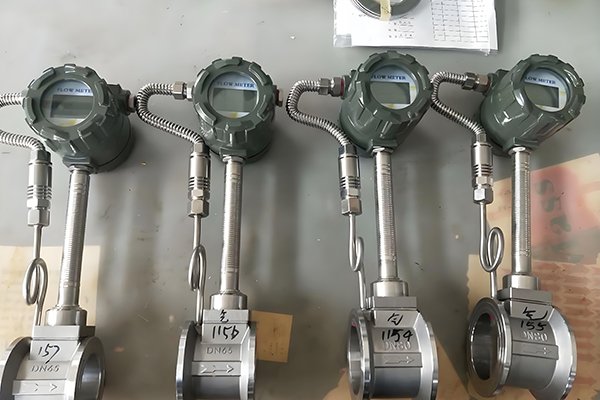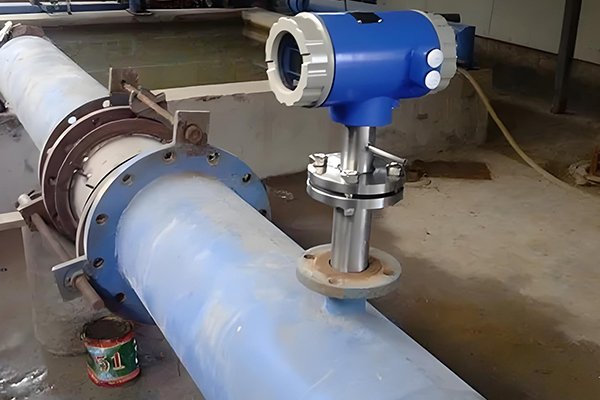What is a Flowmeter
A flowmeter is a precision measurement instrument specifically designed to measure the flow rate of fluids in pipes or open channels. Widely used in industries such as manufacturing, environmental protection, transportation, and scientific research, it serves as an indispensable tool for monitoring and controlling fluid flow.
Its working principle is based on various physical phenomena, including fluid pressure differences, flow velocities, volume changes, or charge movements. For instance, electromagnetic flowmeters measure flow rates by utilizing the movement of electrical charges within the fluid, while ultrasonic flowmeters calculate flow velocities and rates based on the time difference of ultrasonic waves propagating through the fluid. These principles enable flowmeters to accurately and reliably measure the flow of various fluids.
In industrial production, flowmeters play a crucial role in monitoring and controlling fluid flow during production processes, ensuring process stability and efficiency. In environmental protection, they can monitor and control emissions from pollution sources, contributing to reduced environmental pollution. Additionally, flowmeters are also essential in energy management and scientific research.

Types of Flowmeters
Positive Displacement Flowmeters
Principle: Measures fluid flow by accumulating fixed volumes of fluid.
Common Types: Elliptical gear flowmeters, scraper flowmeters, etc.
Characteristics: High accuracy but complex structure, large size, and limited applicability based on fluid type, pipe diameter, and fluid conditions.
Differential Pressure Flowmeters
Principle: Measures flow by establishing a functional relationship between fluid static pressure difference and flow rate.
Common Types: Orifice flowmeters, averaging pitot tubes, etc.
Characteristics: Widely used, sturdy structure, stable and reliable performance, but generally lower accuracy, narrow rangeability, and high installation requirements.
Variable Area Flowmeters
Principle: Measures flow by the force applied to an obstacle in the flow path, where the force is proportional to the flow rate.
Common Types: Rotameters, target flowmeters, etc.
Characteristics: Simple structure and easy to use but have low pressure tolerance and fragile components like glass tubes.
Velocity Flowmeters
Principle: Measures flow by determining the fluid velocity, which is proportional to the flow rate.
Common Types: Turbine flowmeters, electromagnetic flowmeters, ultrasonic flowmeters, etc.
Characteristics: Wide measurement range, high accuracy, particularly suitable for conductive liquids and non-contact measurement applications.
Mass Flowmeters
Principle: Directly measures the mass flow rate of fluids with high precision.
Common Types: Coriolis mass flowmeters, thermal mass flowmeters for gases, etc.
Characteristics: High measurement accuracy, unaffected by changes in fluid temperature, pressure, or density.
Classification by Medium
Liquid Flowmeters: Used to measure the flow of liquids, such as electromagnetic flowmeters and turbine flowmeters.
Gas Flowmeters: Used to measure the flow of gases, such as thermal mass flowmeters for gases and differential pressure gas flowmeters.

Flowmeter specific selection process
The selection process of flowmeters during purchase is a complex and meticulous task, requiring comprehensive consideration of multiple factors to ensure that the chosen flowmeter meets actual needs while delivering excellent performance and reliability. Below is a detailed selection guide:
Clarify Measurement Requirements
Measurement Medium: Determine whether the fluid to be measured is a gas, liquid, or steam.
Fluid Chemical Properties: Understand the fluid’s chemical properties such as corrosiveness, abrasiveness, and fouling tendency to ensure compatibility with the selected flowmeter.
Flow Range: Specify the minimum and maximum flow rates to be measured for selecting an appropriate flow range and accuracy.
Accuracy: Determine the required measurement accuracy based on application needs.
Other Requirements: Consider whether instantaneous flow or total volume (cumulative flow) needs to be measured. Also, consider performance indicators like repeatability and linearity.
Understand Fluid Characteristics
Temperature and Pressure: Determine the fluid’s temperature and pressure conditions to ensure proper operation under these conditions.
Density and Viscosity: Understand the fluid’s density and viscosity characteristics to select a suitable type and configuration.
Select Flowmeter Type
Based on measurement principles and fluid characteristics, choose an appropriate type. Common types include:
Mass Flowmeters: Directly measure the mass flow of fluids, suitable for high-precision measurements of gases or liquids.
Volumetric Flowmeters: Measure flow based on the volume of fluid passing through, applicable to most industrial applications.
Velocity Flowmeters: Calculate flow by detecting the fluid’s velocity in the pipeline.
Differential Pressure Flowmeters: Utilize the pressure difference generated when fluid passes through a restriction device to measure flow.
Positive Displacement Flowmeters: Accumulate fluid flow in fixed volumes, suitable for measuring high-viscosity fluids.
Assess Installation and Environmental Conditions
Installation Location: Determine the installation position and orientation to ensure accurate measurements.
Straight Pipe Length Requirements: Consider the upstream and downstream straight pipe lengths required by some flowmeters to ensure measurement accuracy.
Environmental Conditions: Account for ambient temperature, humidity, electromagnetic interference, safety, explosion-proof requirements, and ensure the instrument operates stably in the working environment.
Consider Economic Factors
Acquisition Cost: Compare prices across different brands and models.
Operating Costs: Factor in energy consumption and maintenance costs.
Service Life: Choose products with longer service lives to reduce long-term costs.
Selection Steps
Initial Selection: Narrow down potential flowmeter types based on fluid type and requirements.
Information Gathering: Collect data and pricing information on the initially selected types to prepare for detailed analysis and comparison.
In-Depth Comparison: Use an elimination process to gradually narrow down to 1-2 types. Repeatedly compare and analyze the requirements factors until a final selection is made.

When selecting a flowmeter, the following aspects need to be carefully considered
Medium Type of Flowmeter
It is crucial to clarify the type of medium to be measured, whether it is a gas, liquid, or steam, as well as its physical and chemical properties, such as temperature, pressure, density, viscosity, corrosiveness, abrasiveness, and fouling tendencies.
Determining the Flow Range of the Measured Medium
Establish the flow range of the medium, including the minimum, typical, and maximum flow rates. The selected instrument’s measurement range should cover these flow rates, and it is advisable to avoid operating near the extreme values to ensure measurement accuracy.
Performance Requirements of Flowmeter
Accuracy: Determine the required measurement accuracy based on application needs. Accuracy may vary across different flow ranges, so selection should be based on actual conditions.
Repeatability: For process control applications, repeatability is a crucial indicator reflecting the consistency of multiple measurements under the same conditions.
Linearity: For applications requiring wide flow range measurements, linearity is an important consideration. A flowmeter with good linearity can maintain high measurement accuracy across the entire flow range.
Signal Output Characteristics: Choose the appropriate signal output type (e.g., analog, digital) and output range based on the requirements of subsequent processing or control systems.
Installation Conditions
Pipeline Layout: Consider the pipeline’s layout direction, flow direction, and the length of upstream and downstream straight pipe sections. Insufficient straight pipe length can affect measurement accuracy.
Space Limitations: Take into account installation space constraints, including pipe diameter, maintenance space, and installation locations for auxiliary equipment (e.g., filters, air eliminators).
Environmental Factors: Evaluate the impact of ambient temperature, humidity, electromagnetic interference, safety, explosion-proof requirements, and pipe vibrations on installation.
Other Considerations
Manufacturer Selection: Choose a manufacturer with a good reputation and after-sales service to ensure instrument quality and technical support.
Technical Support: Given the diversity and complexity of fluid measurement and control conditions, it is recommended to seek professional technical support and guidance during the selection process.
Field Testing: If conditions permit, conduct field testing to verify the measurement accuracy and reliability of the selected instrument.
In summary, when purchasing and selecting a flowmeter, attention should be paid to fluid characteristics, performance requirements, installation conditions, economic factors, and other relevant considerations. By comprehensively evaluating these factors, a selection can be made that best suits the practical application.
Regarding flowmeters, you may also want to learn about:
Product Details of Electromagnetic Flowmeter
Application Cases of Electromagnetic Flowmeter
Product Details of Vortex Flowmeter




